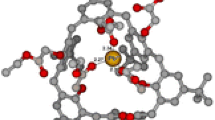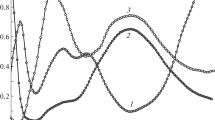Abstract
Experimentally and theoretically derived formation constants of mixed lead halide complexes are compared at 25.0°C and one molar ionic strength. The formation constant of PbBrCl, β11=79±10, is somewhat larger than the theoretical results, β11=55, predicted using the formation constants of PbBr2 and PbCl2. The molar absorptivity of PbBrCl was observed to be intermediate in character between the molar absorptivities of PbBr2 and PbCl2. Determinations of the formation constants of PbBr2Cl− and PbBrCl2 − are in reasonable agreement with the predictions based on the formation constants of PbBr3 − and PbCl3 −. Mixed ligand species dominated the complexation scheme of Pb(II) in our test media.
Similar content being viewed by others
References
D. Dyrssen, D. Jagner, and F. Wengelin,Computer Calculation of Ionic Equilibria and Titration Procedures, (Almquist and Wiksell), Stockholm, 1968) Chap. 2.
J.I. Watters and R. DeWitt,J. Am. Chem. Soc. 82, 1333 (1960).
D. Dyrssen and M. Wedborg inThe Sea, E.D. Goldberg, Ed., (Wiley-Interscience, New York, 1974) Vol. 5, Chap. 5.
P. Tsai and R.P. Cooney,Chem. Geo. 18, 187 (1976).
D.R. Turner and M. Whitfield,J. Electroanal. Chem. 103, 61 (1979).
W. Stumm and P.A. Brauner inChemical Oceanography, J.P. Riley and G. Skirrow, Eds., (Academic Press, London, 1975) Chap. 3.
R.H. Byrne,Mar. Chem. 9, 75 (1980).
T.G. Spiro and D.N. Hume,Inorg. Chem. 2, 863 (1963).
R.H. Byrne,Nature 290, 487 (1981).
S. Ahrland inThe Nature of Seawater, E.D. Goldberg, Ed., Dahlem Konferenzen, Berlin, 1975, p. 219.
C.F. Baes, Jr., and R.E. Mesmer inThe Hydrolysis of Cations, (Wiley-Interscience, New York, 1976), p. 309.
R.H. Byrne and D.R. Kester,J. Sol. Chem. 10, 51 (1981).
R.H. Byrne, R.W. Young, and W.L. Miller,J. Sol. Chem. 10, 243 (1981).
R.H. Byrne and D.R. Kester,J. Sol. Chem. 7, 373 (1978).
D.W. Marquardt,J. Soc. Ind. Appl. Math 11, 431 (1963).
A. Barr, J. Goodnight, J. Sall, and J. Helwig, inA Users Guide to SAS 76, (Sparks, Raleigh, 1976) Chap. 23.
A.M. Smith and A.E. Martell inCritical Stability Constants Vol. IV, (Plenum, New York, 1976), p. 1.
Author information
Authors and Affiliations
Rights and permissions
About this article
Cite this article
Byrne, R.H., Young, R.W. Mixed halide complexes of lead. A comparison with theoretical predictions. J Solution Chem 11, 127–136 (1982). https://doi.org/10.1007/BF01036380
Received:
Issue Date:
DOI: https://doi.org/10.1007/BF01036380




